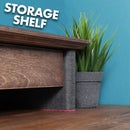Introduction: Riverbed Coffee Table
This is the final (for now) charity project I'll be making. I've always wanted to try making a resin table. I've seen a lot of different examples so thought Id give it a go to help raise money for the Birmingham Childrens Hospital.
I have a build video that shows how I made it (including my mistakes lol) :
Materials Used:
- American Black Walnut
- 18mm Plywood
- Water Simulation Epoxy Casting Resin (Self Degassing)
- Fish Tank Pebbles
- Moss
- Spray Laquer
- Spray Polyurethane
- Brush On Polyurethane
- Black Paint
- Red Paint
- Melamine
- Hot Glue
- Machine Screws M6
- T Nuts M6
- Milliput
Tools Used:
- Mitre Saw
- Jigsaw
- Drill & Impact Driver
- Screwdriver
- Sander
- Track Saw
- Clamps
- Painters Tape
Step 1: Glue Up the Legs
In keeping with my other charity projects I wanted to make a feature of exposed plywood edges. I started by cutting 3cm wide pieces of 18mm plywood to 35cm in length.
These are then arranged to form a square. Each layer overlaps the one underneath so it creates a finger joint. I glued up 6 layer to create the leg. So for 2 legs I used 48 pieces of 3cm x 35cm plywood.
Step 2: Prepare the Top
For the top I used some 36mm thick American Black Walnut. The boards were 15cm wide by 100cm. Because I wanted to make a riverbed table I drew a random curve along the edge of one of the boards. I then cut it out with my jigsaw tilted to 30 degrees. The tilt should make it appear more like a riverbank. I used the off cut piece to trace the shape onto the other board and cut it out the same way.
I'll be pouring resin into the table so I'll need a bottom added between the boards. So it can sit flush I used the router to create a rebate on both boards. I started by using a straight edge guide referencing off the straight edge. I could then remove the rest of the waste freehand with the router.
The bottom was a simple rectangle piece of 6mm plywood. I traced round the "river bank" edges, masked off the edges and painted the inside black. This will make any exposed areas less visible later. While still masked off I gave it a couple of coats of spray lacquer. I did this as a just in case the paint reacted with the resin. The masked off areas wil allow the wood glue to adhere properly. The plywood then got glued into place and held with screws while the glue dried.
Step 3: Create the Riverbed
I got some fish tank pebbles to fill the table with. They are much more interesting colours and markings compared to regular gravel you can get from a builders merchants. I washed them to make sure there wasn't any small particles that may float in the resin.
In every charity project I've had a representation of the childrens hospital logo which is a red balloon. This project is no different. I got a large stone from my garden, cleaned it up and then painted it red. This also got a coat of spray lacquer as a just in case.
Obviously pouring resin into the table as is would end up with resin all over the floor so I clamped on some scrap pieces of melamine. I sealed around the edges with hot glue too. I could then arrange the pebbles and also add some moss for some more detail. I made sure to leave a space at the edges with no pebbles in case i needed to cut the edges later. i wouldnt want my saw to hit a stone. The final addition was a penny. Just for some added interest.
The resin I used is self degassing. It takes 5 days to fully cure so it has plenty of time to vent any trapped bubbles. It gets mixed to a ratio of 1:0.5. I poured the maximum allowed for the resin which is 2L. It took 3 days for it to become hard so I could then pour a second layer to fill the table.
Step 4: Create the Joinery for the Legs
I didn't want to just glue the legs to the table top as it wouldn't allow for the walnut to expand and contract with the seasons, it would also make it harder to transport so I opted for removable legs.
To make that possible I routed a pocket out of the top of the legs. This is to receive a piece of 18mm plywood. That piece gets 2 holes drilled all the way through, and through the legs. It also gets a slight reassess with a spade bit. This is so the T nuts can sit flush to the surface and be held in place.
To fit the T nuts I taped a washer onto a clamp and used it to squeeze the T nut into the hole. This works a lot better than hammering it into place.
machine screws can then be used to hold it into place.
Step 5: Clean Up the Top
With the resin set I could remove the melamine. In parts it came away cleaning but it others it was stuck on quite firmly. I decided to get a nice clean edge I would cut them with a track saw. This is why I left a gap with no stones on the edges earlier. It gave a really nice edge.
Because I overfilled the resin I would need to level it. I thought sanded would take ages so I tried using my hand held electric planer. On the areas with resin on wood it gave a really nice finish, however, on the resin itself it took big chunks out. With the damage already done I level the top and then filled the chips with more resin. Luckily they clear up with the resin added and I could go back to sanding when it was all set.
I sanded to 80 grit then 240 grit and then 1200 grit.
Step 6: Clean Up the Bottom
I shouldn't have painted the underside of the plywood. I needed to fill the screw holes and I also needed exposed wood for the wood glue to adhere to. So I sanded away most of the paint, filled the screw holes with black Milliput, masked off the edges and 2 areas where the legs will be attached and then painted it again.
The painters tape gave a really nice crisp clean edge.
I then glued on the pieces of plywood that had the T nuts inside. With the glued into place the legs can be attached with the machine screws.
While I had the paint out I decided to paint the edges of the plywood legs.
Step 7: Polish the Top
I was pleased with how sanding to 1200 grit looked on the top but I thought I would try to take it further. I used some rotten stone powder mixed with water to act as an abrasive. I polished the top all over which gave a much clearer effect than 1200 grit.
Step 8: Finish the Table
I had a nightmare with the finish on this table. I first used satin polyurethane which I applied with a brush. It looked great on the underside of the table top and the plywood legs. But when I applied it to the resin the brush strokes where very visible. It made the resin really clear which was great but I wasn't happy with the brush marks so I sanded it all back down.
I then tried some spray satin polyurethane. I thought it would give the same results but with no brush marks this time. I was wrong. The additives in the satin spray made the resin cloudy. So again, I sanded it all back down.
Finally I used some gloss spray polyurethane which worked brilliantly. I was so relieved to get the finish right in the end.
Step 9: Attach the Legs
All thats left to do is attach the legs. The slot on top of the plywood pieces and then get attached with machine screws. The machine screws tighten onto the t nuts really well.
With the legs attached the table is done. I really hope you like it. I made a lot of mistakes with this one but I persevered and I'm really happy with the results.

Second Prize in the
Homemade Gifts Contest 2017

Runner Up in the
Furniture Contest 2017

Participated in the
Reclaimed Contest 2017













